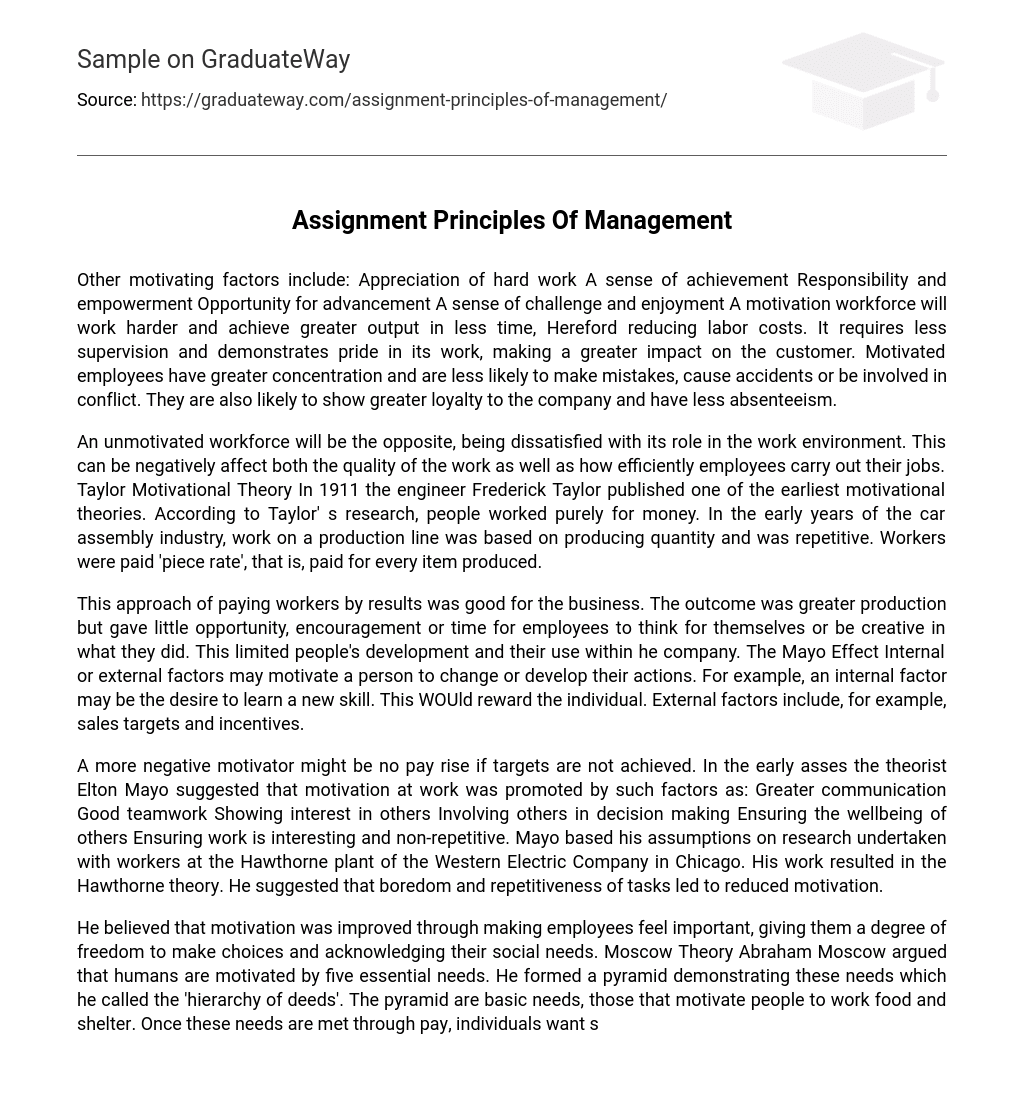Other motivating factors include: Appreciation of hard work A sense of achievement Responsibility and empowerment Opportunity for advancement A sense of challenge and enjoyment A motivation workforce will work harder and achieve greater output in less time, Hereford reducing labor costs. It requires less supervision and demonstrates pride in its work, making a greater impact on the customer. Motivated employees have greater concentration and are less likely to make mistakes, cause accidents or be involved in conflict. They are also likely to show greater loyalty to the company and have less absenteeism.
An unmotivated workforce will be the opposite, being dissatisfied with its role in the work environment. This can be negatively affect both the quality of the work as well as how efficiently employees carry out their jobs. Taylor Motivational Theory In 1911 the engineer Frederick Taylor published one of the earliest motivational theories. According to Taylor’ s research, people worked purely for money. In the early years of the car assembly industry, work on a production line was based on producing quantity and was repetitive. Workers were paid ‘piece rate’, that is, paid for every item produced.
This approach of paying workers by results was good for the business. The outcome was greater production but gave little opportunity, encouragement or time for employees to think for themselves or be creative in what they did. This limited people’s development and their use within he company. The Mayo Effect Internal or external factors may motivate a person to change or develop their actions. For example, an internal factor may be the desire to learn a new skill. This WOUld reward the individual. External factors include, for example, sales targets and incentives.
A more negative motivator might be no pay rise if targets are not achieved. In the early asses the theorist Elton Mayo suggested that motivation at work was promoted by such factors as: Greater communication Good teamwork Showing interest in others Involving others in decision making Ensuring the wellbeing of others Ensuring work is interesting and non-repetitive. Mayo based his assumptions on research undertaken with workers at the Hawthorne plant of the Western Electric Company in Chicago. His work resulted in the Hawthorne theory. He suggested that boredom and repetitiveness of tasks led to reduced motivation.
He believed that motivation was improved through making employees feel important, giving them a degree of freedom to make choices and acknowledging their social needs. Moscow Theory Abraham Moscow argued that humans are motivated by five essential needs. He formed a pyramid demonstrating these needs which he called the ‘hierarchy of deeds’. The pyramid are basic needs, those that motivate people to work food and shelter. Once these needs are met through pay, individuals want safety and security through, for example, good job conditions. Social needs refer to the need to belong, to be part of a group.
Self-esteem may arise from a promotion. Then, it will be Self fulfillment – the area for creativity, challenge and interest. Moscow suggested that achieving one level motivates us to achieve the next. Herbert Theory In 1959 Frederick Herbert developed the Two-Factor theory of motivation. His research showed that certain factors were the true motivators or satisfiers. Hygiene factors, in contrast, created dissatisfaction if they were absent or inadequate. Dissatisfaction could be prevented by improvements in hygiene factors but these improvements would not alone provide motivation.
Herbert showed that to truly motivate an employee a business needs to create conditions that make him or her feel fulfilled in the workplace. Conclusion Employee motivation is an important task for managers. Early motivational theory such as that of Taylor suggested that pay motivated workers to improve production. However businesses now need employees to have greater titivation and have a stake in the company for which they work, as shown by Mayo. Moscow and Herbert theory demonstrated that the employees are motivated by many different factors.
Every company have provides opportunities for its managers and staff to take a share and a greater interest in their own employment. Since every employee is an individual, with different needs and aspirations, the process of reviews and personal development. This benefits the individual by providing career progression. It also benefits that every company by ensuring the business can deliver high levels of customer service through its skilled employees. Source: The Times 100 Question [50 Marks] Length: 2,000 – 2,500 words Describe what is meant by motivation.
You are require to choose the company that you prefer. You need to do the report about how does the company that you prefer can motivated the employees. In the report, you should include the following details: What is meant by motivation Identify the company background Describe the function management of the company Types of non-financial reward and financial reward might the company use to motivate employees Describe the effects of an unmotivated workforce on a company How does the company benefit from ensuring that its workforce is titivated?





